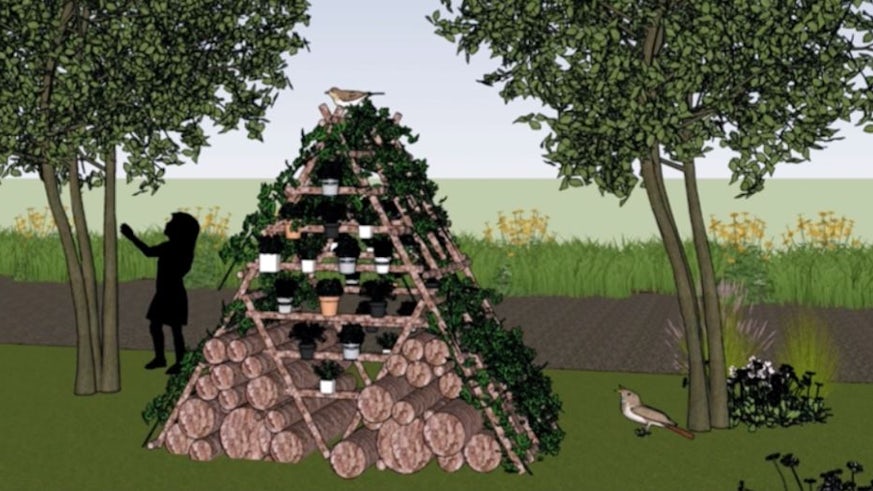Finding synergy between the natural and human worlds
27 April 2021

Using natural materials and community knowledge, the Masters in Architectural Design Synergetic Landscapes unit has been working on design solutions to global and local challenges facing nature and wildlife.
The Welsh School of Architecture’s MA in Architectural Design programme focuses on design-led research techniques and methods to inform learning process and research explorations. Students develop existing design skills by focusing on how design thinking might address current global challenges. This approach offers an intense and lively forum for the exploration and discussion of design issues.
For this reason, the course places particular emphasis on using design as a means to conduct research. Researching through design is a creative activity that closely integrates the process of designing with the act of researching, so that they can mutually inform each other. Students explore problems by making and testing design propositions, introducing and developing established knowledge as and when required. Through project work, students draw on knowledge from many disciplines.
The MA AD Synergetic Landscapes unit is closely linked with Cardiff University's Community Gateway project and has been working in the local community of Grangetown over the past year. The collaborative design unit aims to integrate a variety of living and non-living agents within the community in co-designing flourishing environment with and for all. To find out more about the unit's work in Grangetown please visit the Systemic Approach to Architectural Performance website.
In 2020/2021, nine students worked collaboratively with Grangetown residents and the Community Gateway team to develop ideas for synergetic landscape and biocentric solutions, focusing on finding solutions to co-habitation and sustainable homes for nature.
Find out more about the students’ design solutions below:
Biocentric Wormery
Hussa Alghunaim
How do animals and creatures contribute to our existence and the reverse? How can Biocentrism help us find a balance between the natural and human worlds? Can biocentrism help with cohabitation solutions. Maybe a look at a sustainable wormery can hold the answers.
Watch Hussa Alghunaim's concept video here
Wildlife-Friendly Garden (Eco Café)
Zhen Zhang
This video is about the description of the design of the wildlife-friendly garden. The purpose of my design is to create a wildlife-friendly garden. Today, people are increasingly emphasizing coexistence with nature, and building a device that "accommodates living things" may become a new design requirement in the future. Animals of different species usually do not live together. However, in fact, we can often see different animals eating together in the park, such as squirrels and birds. So my design concept is to design a space for animals to temporarily share together. We can call it Garden Eco Cafe. In order to facilitate DIY for everyone, I chose the hexagonal modular design as the prototype, because hexagons can be infinitely stitch-able and have good reproduction.
Watch Zhen Zhang's concept video here
Pixel Tree
Yuting Xie
"Pixel tree" is a DIY installation made of branches and ropes composed of ‘single boxes’, which aims to reduce soil pollution. Residents can have their own ‘single box’ to grow fruits and vegetables or plants, and they will incorporate to complete a ‘pixel tree.’
Birds’ Nest
Yuhan Ma
When considering security, the first thing that comes to mind is home. What family brings to people is an irreplaceable sense of security. The house is our refuge, and for birds, their nest is their refuge.
Therefore, my thoughts naturally came to the shape of the house, because I wanted to give the bird family a quick house. I also hope that through my actions, more people can work together to provide birds with a home.
Greenhouse Bird's Nest Concept:
Tian Wang
The Greenhouse Nest is a DIY device designed to reduce the impact of the greenhouse effect on birds, consisting of a large nest assembly in the form of five eggs.
Watch Tian’s concept video here
Natural Feeder
Ningjia Cui
The design plans a series of plants that can work together to provide year-round food and habitat for insects, birds, etc.
Biological Space
Kai Huang
The concept of an biological space for kids to have better contact with animals.
This structure will blur the boundary between indoor and outdoor, allowing more green growth to grow on the wall through it.
A home for Hedgehogs
Jiayu Sun
Hedgehogs are cute animals in the garden. Let us build a comfortable shelter for them, so that children can also meet the elves in fairy tales in the park.
Watch Jiayu’s concept video here
A Natural Shelter
Jiayang Jiang
Nowadays animals are facing many threats. This structure combines natural plants to provide safe shelters for animals, allowing animals, plants and people to play in a safe space
Watch Jiayang’s concept video here
To find out more about the MA in Architectural Design programme and n=how to apply, please visit the course pages.